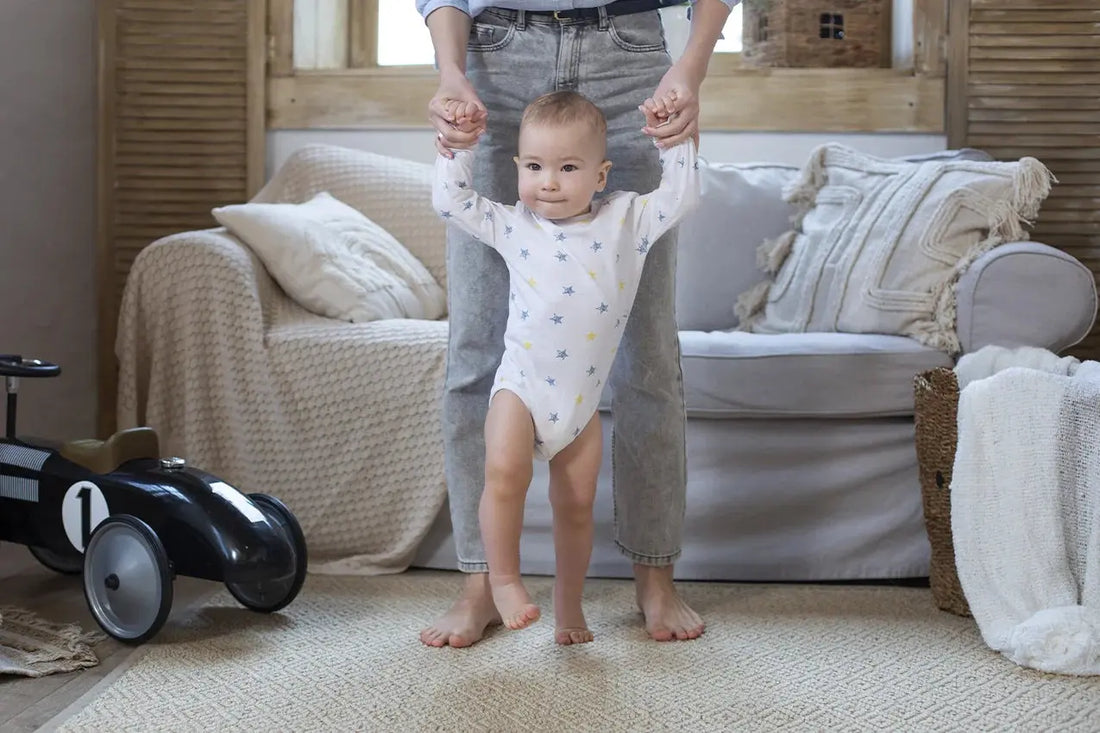
How to help baby walk: 7 practical and effective tips
Share
Baby's first steps are an exciting and significant time for the whole family. Help baby walk can seem like a challenge, but with a few practical tips, it can also be a joyful time of discovery and learning. In this article, we offer 7 effective tips to encourage this crucial development.
Steps to Help Baby Walk – Effective Tips for Parents
Important milestones
Before your baby starts walking, they go through several developmental stages. These milestones are essential for building their confidence and physical strength. Starting with standing up, then holding onto furniture for support, is often the first step. Then they learn to take one step, then two, fueling their curiosity about the world around them.
Every child is unique, some can walk at 10 months, while others can take their time until 18 months. It depends on their physical development and confidence. To encourage them, create a supportive environment with plenty of free space to explore.
Create a safe path
- Make sure the floor is secure and free of obstacles.
- Use rugs or non-slip surfaces to minimize falls.
- Place furniture appropriate to baby's height, so that he can hold on easily.
Encourage baby's confidence
Support their efforts
When baby starts taking his first steps, it is crucial to provide warm support. Encourage him by applauding each small step. This will show him that he is on the right track and will build his confidence. The vulnerability of little ones is an opportunity for encouragement.
Spend time playing with him, encouraging him to get up and walk. Use engaging toys to motivate him to move. For example, holding a toy out of his reach will encourage him to move toward you.
Use suitable accessories
Provide visual aids, such as a pusher. Adaptive toys, such as the La BB Shoes , can provide stability while learning. Make sure these devices are designed to encourage walking without compromising safety.
The importance of ground time
Promote gross motor skills
Tummy time is essential for muscle development. It helps strengthen the back and neck muscles, preparing your baby to stand up and walk. Make sure to spend time on these activities, as they make later movements more natural.
Encouraging crawling or crawling also prepares your baby to stand up. These movements help your baby's muscles learn to support their weight, a crucial part of the walking process.
Take care of the environment
Arrange the space safely
A safe environment is key to encouraging walking. Remove any dangerous or sharp objects from the play area. Keep sharp furniture away and use corner protectors to prevent injuries from falls. Safety should always be your priority during this exploration phase.
Also create activities that are appropriate for his developmental level. Provide opportunities to get up and walk around when you place them close to him. This will add motivation and make him want to explore his space.
Surfaces suitable for walking
The nature of the surfaces your baby walks on can have a significant impact on their experience. Soft surfaces, such as carpet, are ideal at first. As your baby's confidence increases, you can introduce different materials to help them adjust to new sensations.
If you are planning outdoor activities, make sure the ground is flat and secure. Avoid slippery surfaces that could throw you off balance.
Conclusion
The journey to walking is a fascinating and often adorable one. By implementing these practical tips, you can help your baby develop their walking skills while having fun. Remember that every child progresses at their own pace, and the most important thing is to provide them with warm support and a safe environment. Observe their development and celebrate each little step. Walking will be just one of many rewarding stages in their development, and your encouragement will be invaluable in this journey.
FAQs about baby walking
Q: At what age does a baby start to walk?
A: Most babies start walking between 10 and 18 months. However, there is great variability depending on each child's individual development.
Q: How can I encourage my baby to take his first steps?
A: You can encourage your baby to walk by providing stimulating toys, loving support, and creating a safe play space for exploration.
Q: What if my baby doesn't walk at an older age?
A: If your child has not started walking by 18 months, it may be a good idea to see a pediatrician to assess his or her development.
Q: What are the signs that my baby is ready to walk?
A: Signs include standing without assistance, moving around by holding on to furniture, and showing interest in moving around on your own.



















